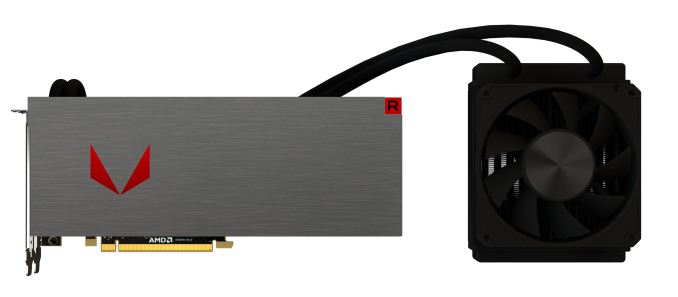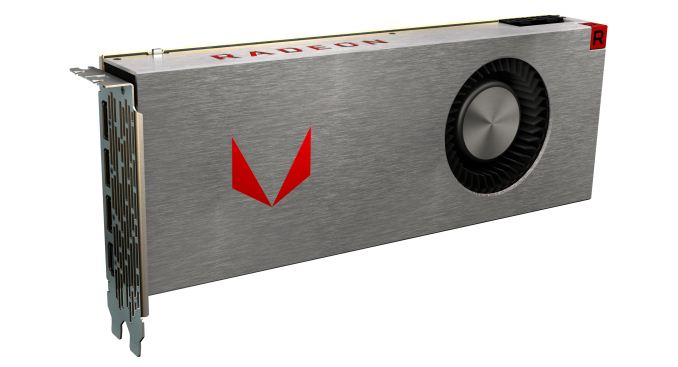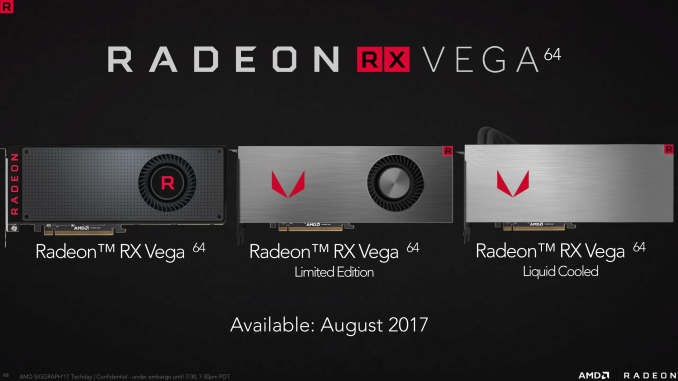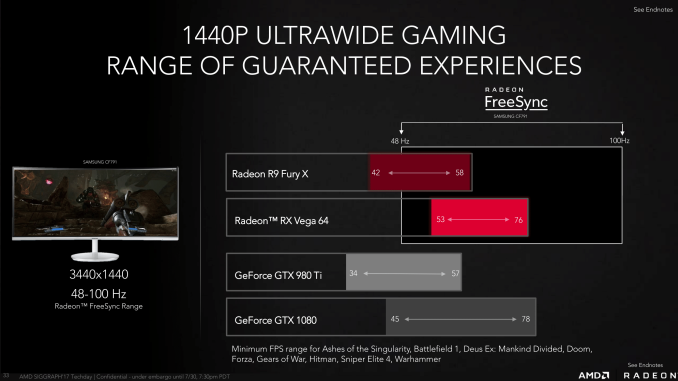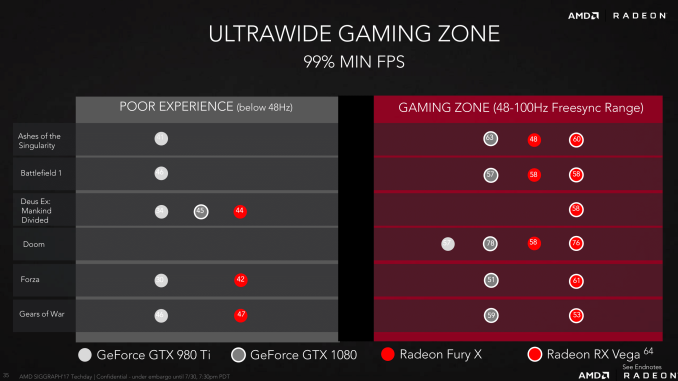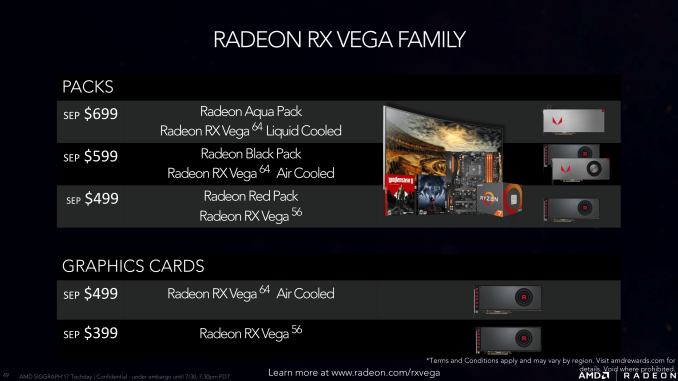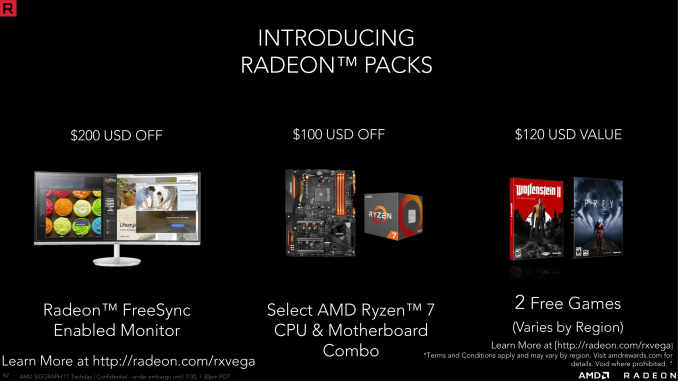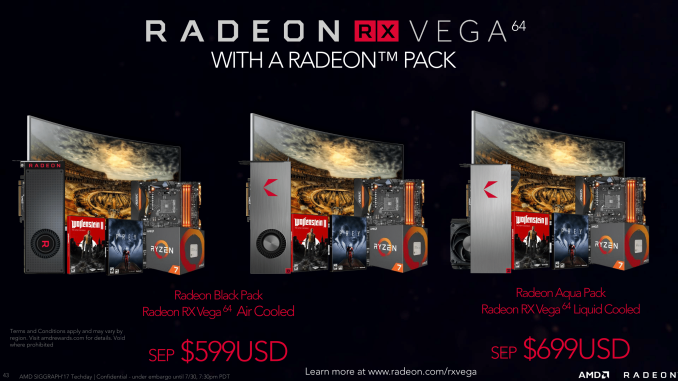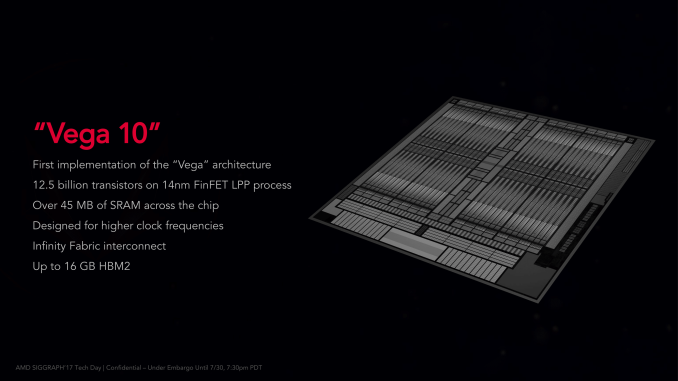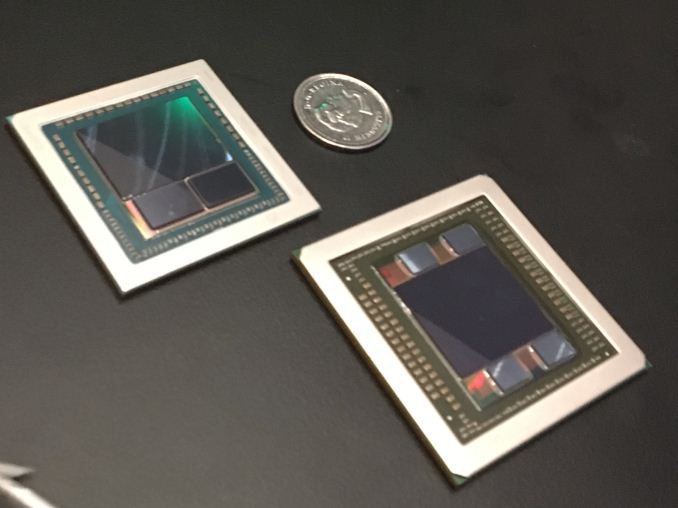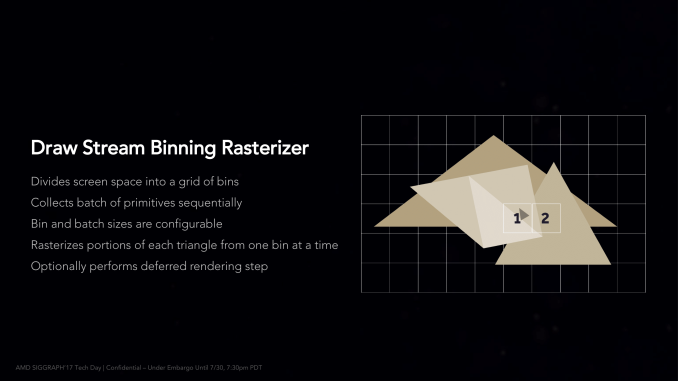
Original Link: https://www.anandtech.com/show/11680/radeon-rx-vega-unveiled-amd-announecs-499-rx-vega-64-399-rx-vega-56-launching-in-august
Radeon RX Vega Unveiled: AMD Announces $499 RX Vega 64 & $399 RX Vega 56, Launching August 14th
by Ryan Smith on July 30, 2017 10:30 PM EST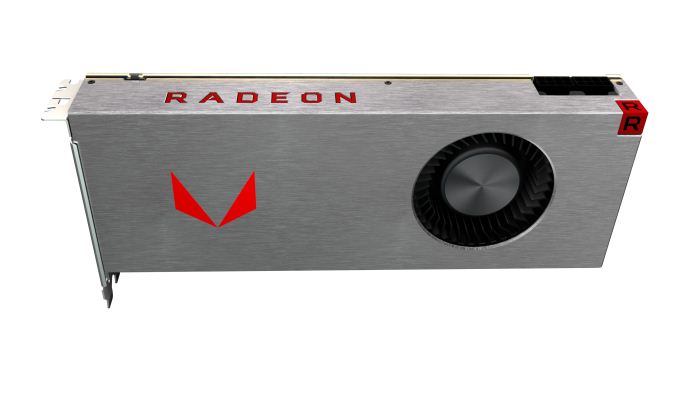
At this point, one must give credit to AMD for their marketing program for the Radeon RX Vega. The company has opted to drip feed information over many months, and as a result this has kept the public interested in the architecture and consumer RX Vega cards. Since it was by name back in the spring of 2016, we’ve had architecture previews, product teasers, and even a new Frontier Editions to tide us over. Suffice it to say, there’s a great deal of fascination in finally seeing the products AMD has been beating the drums about for so long.
To that end, there’s good news today and there’s bad news today. In the interest of expediency, I may as well start with the bad news: today is not the launch day for the Radeon RX Vega. In fact, only right before this embargo expired did AMD even announce a launch date: August 14th. So for reviews, performance analyses, and of course purchasing, everyone will have to hold on just a bit longer.
The good news then is that even if today isn’t the Radeon RX Vega launch, AMD is finally making significant progress towards it by announcing the cards, the specifications, and the pricing. Gamers may not be able to buy the cards quite yet, but everyone is going to have some time to size up the situation before the proper launch of the cards next month. Overall this situation is very similar to the unveiling of the Radeon R9 290 series, where AMD announced the cards at a product showcase before launching them the following month.
So without further ado, let’s dive into the Radeon RX Vega family of cards and their specifications.
| AMD Radeon RX Series Specification Comparison | ||||||
| AMD Radeon RX Vega 64 Liquid | AMD Radeon RX Vega 64 | AMD Radeon RX Vega 56 | AMD Radeon R9 Fury X | |||
| Stream Processors | 4096 (64 CUs) |
4096 (64 CUs) |
3585 (56 CUs) |
4096 (64 CUs) |
||
| Texture Units | 256 | 256 | 224 | 256 | ||
| ROPs | 64 | 64 | 64? | 64 | ||
| Base Clock | 1406MHz | 1247MHz | 1156MHz | N/A | ||
| Boost Clock | 1677MHz | 1546MHz | 1471MHz | 1050MHz | ||
| Memory Clock | 1.89Gbps HBM2 | 1.89Gbps HBM2 | 1.6Gbps HBM2 | 1Gbps HBM | ||
| Memory Bus Width | 2048-bit | 2048-bit | 2048-bit | 4096-bit | ||
| VRAM | 8GB | 8GB | 8GB | 4GB | ||
| Transistor Count | 12.5B | 12.5B | 12.5B | 8.9B | ||
| Board Power | 345W | 295W | 210W | 275W (Typical) |
||
| Manufacturing Process | GloFo 14nm | GloFo 14nm | GloFo 14nm | TSMC 28nm | ||
| Architecture | GCN 5 | GCN 5 | GCN 5 | GCN 3 | ||
| GPU | Vega 10 | Vega 10 | Vega 10 | Fiji | ||
| Launch Date | 08/14/2017 | 08/14/2017 | 08/14/2017 | 06/24/2015 | ||
| Launch Price | $699* | $499/599* | $399/499* | $649 | ||
All told, AMD will be releasing 3 different RX Vega cards. All 3 cards are based on the same GPU, Vega 10, which powers the already released Radeon Vega Frontier Edition. So if you’re familiar with that card, then you should have an idea of what to expect here.
The top of AMD’s lineup is the Radeon RX Vega 64 Liquid Cooled Edition. This is a fully enabled Vega 10 card and it has the highest clockspeeds and highest power requirements of the stack. All told, this is 64 CUs, 64 ROPs, boosting to 1677MHz, and paired with 8GB of HBM2 memory clocked at 1.89Gbps. Typical board power for the card is rated at 345W. To cool such a card, you of course will want liquid cooling, and living up to the name the card, AMD has included just that, thanks to a pump and 120mm radiator.
The second member of AMD’s lineup is the shorter-named vanilla Radeon RX Vega 64. Unlike its liquid cooled predecessor, this is a traditional blower-type air cooled card. And for the purposes of AMD’s product stack, the company is treating the vanilla Vega 64 as the “baseline” card for the Vega 64 family. This means that the company’s performance projections are based on this card, and not the higher-clocked liquid cooled card.
The vanilla Vega 64 utilizes the same fully enabled Vega 10 GPU, with 64 CUs and 64 ROPs. The card’s reduced cooling capacity goes hand-in-hand with slightly lower clockspeeds of 1247MHz base and 1546MHz boost. Paired up with the Vega GPU itself is the same 8GB of HBM2 as on the liquid cooled card, still running at 1.89Gbps for 484GB/sec of memory bandwidth. Finally, this card ships with a notably lower TBP than the liquid cooled card, bringing it down by 50W to 295W.
Meanwhile, unlike any of the other cards in the RX Vega family, the Vega 64 will come in two shroud design options. AMD’s reference shroud is a plastic/rubber design similar to what we saw on the reference Radeon RX 480 launched last year. AMD will also have a “limited edition” version of the card with the same hardware specifications, but replacing the rubber shroud with a brushed aluminum shroud, very similar to the one found on the Vega Frontier Edition. Though it’s important to note that the only difference between these two cards is the material of the shroud; the cards are otherwise identical, PCBs, performance, cooling systems, and all.
On that note, AMD has only released a limited amount of information on the cooler design of the Vega 64, which is of particular interest as it’s an area where AMD struggled on the R9 290 and RX 480 series. We do know that the radial fan is larger, now measuring 30mm in radius (60mm in diameter). The fan in turn is responsible for cooling a heatsink that’s attached to the Vega 10 GPU + memory package via a vapor chamber, a typical design choice for high performance, high TDP video cards.
Finally, the last member of the RX Vega family is the Radeon RX Vega 56. The obligatory cut-down member of the group, this card gets a partially disabled version of the Vega 10 GPU with only 56 of 64 CUs enabled. On the clockspeed front, this card also sees reduced GPU and memory clockspeeds; the GPU runs at 1156MHz base and 1471MHz boost, while the HBM2 memory runs at 1.6Gbps (for 410GB/sec of memory bandwidth). Following the traditional cut-down card model, this lower performing card is also lower power – and quite possibly the most power efficient RX Vega card – with a 210W TDP, some 85W below the Vega 64. Meanwhile, other than its clockspeed the card’s HBM2 memory is untouched, shipping with the same 8GB of memory as the other RX Vega members.
Moving on, perhaps the burning question for many readers now that they have the specifications in hand is expected performance, and this is something of a murky area. AMD has published some performance slides for the Vega 64, but they haven’t taken the time to extensively catalog what they see as the competition for the card and where the RX Vega family fits into that. Instead, what we’ve been told is to expect the Vega 64 to “trade blows” with NVIDIA’s GeForce GTX 1080.
In terms of numbers, the few numbers that the company has published have focused on minimum framerates over average framerates, opting to emphasize smoothness and the advantage they believe to have over the aforementioned GTX 1080. As always, competitive numbers should be taken with a (large) grain of salt, but for the time being this is the best guidance we have on what to expect for the RX Vega family’s performance.
Otherwise for the Vega 64 Liquid and Vega 56, we don’t have any other performance figures. Expect the former to outperform the air cooled Vega 64 – though perhaps not massively – while the Vega 56 will come in notably lower.
Buying Radeon RX Vega: Prices & Bundles
Now that we’ve taken a look at the cards, let’s take a look at the prices. Card pricing and availability on RX Vega is not going to be very straightforward, so this requires a bit of focus.
First off, AMD will be offering RX Vega cards both with and without bundles. The latter point is going to be especially important, because these are no ordinary bundles. But if you just want a card – full stop – then AMD will be selling both the Vega 56 and Vega 64 stand-alone. These cards will go for $399 and $499 respectively. These prices, coincidentally enough, are relatively close to the prices of the GeForce GTX 1070 and GTX 1080, give or take some price fluctuations due to cryptocurrency mining demands.
As for AMD’s fancier Vega 64 Limited Edition and Vega 64 Liquid Cooled Edition card, these will not be available on a stand-alone basis at all. If you want these cards, they will only be available as part of a bundle.
However what’s not being said by AMD is how much of the RX Vega launch supply will be allocated to stand-alone cards. For various reasons the bundles are more lucrative to AMD and its partners, and as a result it’s difficult to imagine AMD sending the bulk of the cards to stand-alone configurations, or even a 50-50 split. Instead I expect that the bulk of the cards will go towards the bundles. So while we’re going to have to see what launch day brings next month, I’m not convinced that stand-alone cards will be available in great numbers.
Instead, if you want an RX Vega on launch day, and this is where things take an interesting turn. AMD has offered hardware bundles and game bundles before, but for their latest Radeon family, they have never offered a bundle quite like this.
For what amounts to a $100 premium, AMD is doing a combined software and hardware bundle. AMD calls these the Radeon Packs, and they include bundled games and hardware discounts. In short, if you commit to buying an RX Vega card for $100 more, you get access to AMD’s best cards with additional games and some sizable hardware discounts.
Overall the bundle contains the following items: an RX Vega video card, a $200 discount on Samsung’s CF791 34-inch WQHD Curved Freesync monitor, a $100 discount on a Ryzen 7 + motherboard bundle, and 2 AAA games (for North America this is Wolfenstein II and Prey, coming from AMD’s close partner Bethesda).
Bundle Contents
- AMD Radeon RX Vega Card
- 2 Bundled Games (For US: Wolfenstein II and Prey)
- $200 Discount: Samsung CF791 34-inch Widescreen Freesync Monitor
- $100 Discount: Ryzen 7 + Motherboard Combo
Perhaps the most important aspect of the deal is how the bundles work. Unlike traditional retailer bundles, these AMD bundles require purchasing the Radeon Pack version of the card. If you buy the stand-alone RX Vega cards, then you won’t get the games or qualify for the hardware discounts. And these Radeon Pack SKUs are, in turn, priced $100 over the stand-alone cards.
As for the contents of the bundle, the bundled games are rather straightforward: the bundle simply comes with the games (presumably in voucher form). For the hardware however, the discounts come in the form of an instant rebate on the hardware, not a voucher or other “bankable” form. This means that if you buy a Radeon Pack SKU, you must buy the discounted hardware at the same time to get the discount. You are not required to buy the hardware – instead paying the $100 premium just for the card selection and included games – but the discounts cannot be saved until later. It’s now or never.
All told then, the total cost to take full advantage of a Radeon Pack will not be cheap. The packs themselves are priced at $499 for the Vega 56 pack (Red Pack), $599 for a Vega 64 pack (Black Pack), or $699 for a Vega 64 Liquid Cooled Edition pack (Aqua Pack). Meanwhile, turning to our favorite retailer Newegg, the Samsung CF791 currently retails for $950, a Ryzen 7 1700X is $339, an a good X370 motherboard is $129 (or more). This would bring the total cost, after the $300 in rebates, to $1717. And this doesn’t account for external factors, such as which retailers are participating and whether they all price the most expensive component, the Samsung monitor, at the same $950 price.
The Rationale for Radeon Packs
Though unconventional, for AMD there is a reason behind these Radeon Packs. There are several, in fact.
First and foremost, AMD wants to sell gamers on a whole ecosystem, not just a single video card. They want to get gamers setup with a variable refresh monitor for smoother gaming, with the Samsung CF791 being a particularly popular (and large) monitor that’s a good fit for the expected performance of the RX Vega cards. Meanwhile as AMD is a GPU and CPU manufacturer, they of course want to get gamers buying both from them at the same time. It’s perhaps the strongest ecosystem play you can see a component vendor make, outside of a fully vertical company like Apple.
But more than that, the Radeon Packs are an attempt by AMD to “poison the well” for cryptocurrency miners, in order to ensure most RX Vega cards go to gamers. While we already have a basic idea of RX Vega’s mining performance via Vega FE, AMD seems genuinely concerned about miners scooping up RX Vega as well. So they want to prevent that from happening, and to assuage their gaming customers, they want to be seen as favoring gamers as well.
The bundles in turn are a shot at making RX Vega cards less palatable to miners by inflating their cost. All the miners need is a video card, so the extra $100 spent on the discounts they won’t use and the bundled games they won’t play just eats into the bottom line. For gamers on the other hand, hardware and software bundles have been a common fixture for years, and AMD believes that by bundling the cards with other things gamers would want, they can keep the cards desirable to gamers while making them less desirable to miners.
Even then it’s not a sure-thing for AMD. If RX Vega were to be especially awesome at mining, then miners could very well eat the cost of the card (this is how we got $900 R9 290s). Alternatively, for gamers who don’t need a new monitor or don’t want the games, then the bundles represent add-ins that inflate the cost of cards for them as well. So it will be very interesting to see how this plays out.
Otherwise the final factors – and things not said by AMD – are volume and pricing. If AMD only expects a limited number of cards to be on the market at the launch, then shifting most of the supply into the bundles is a chance to de facto charge more for the cards and make a bit more profit off of their sale. If they’re going to sell out anyhow, why not charge more?
At any rate, while the focus for the moment is on the August 14th launch of the RX Vega cards, the bundles will be a longer-term play for AMD than just the launch window. The company hasn’t set a definitive expiration window for the program, and we’ve been told to expect it to continue through at least the rest of the year. So depending on how things go, it’s entirely possible AMD could continue to offer the Radeon Packs well into the future if they’re successful.
Features & the Future Launch
Last but not least, along with today’s card announcements, AMD has also lifted the embargos on the architectural elements of the Vega 10 GPU. While there are no new architecture features to discuss – it turns out AMD was rather thorough with their preview at the start of this year – there’s still quite a bit in the way of details to dig into here. In fact it's more than I can hope to cover in a single day, let alone the few hours I’m getting to write this article ahead of AMD’s embargo. So I want to hit the highlights.
First and foremost, AMD has clarified that they do not consider Vega 10 to be a high performance computing (HPC) chip, unlike Hawaii. In particular, Vega 10’s native FP64 rate is just 1/16, like AMD’s other consumer chips. And the chip, while supporting HBM2’s native ECC mode, doesn’t have ECC on its internal pathways. This doesn’t mean that the chip can’t be placed in a server – its FP16 and INT16/INT8 performance is the cornerstone of its existence as part of the Radeon Instinct family. But that’s still a different market than traditional HPC. When we might see another HPC chip from AMD is anyone’s guess at this moment.
Second of all, we have a formal die size and transistor count for Vega 10. The GPU is officially 486mm2, containing 12.5B transistors therein. That amounts to 3.9B more transistors than Fiji – an especially apt comparison since Fiji is also a 64 CU/64 ROP card – all the while being 112mm2 smaller than Fiji (despite the higher transistor count) thanks to the higher density of GloFo’s 14nm LPP process, which AMD is using to fab the chip.
Talking to AMD’s engineers, what especially surprised me is where the bulk of those transistors went; the single largest consumer of the additional 3.9B transistors was spent on designing the chip to clock much higher than Fiji. Vega 10 can reach 1.7GHz, whereas Fiji couldn’t do much more than 1.05GHz. Additional transistors are needed to add pipeline stages at various points or build in latency hiding mechanisms, as electrons can only move so far on a single clock cycle; this is something we’ve seen in NVIDIA’s Pascal, not to mention countless CPU designs. Still, what it means is that those 3.9B transistors are serving a very important performance purpose: allowing AMD to clock the card high enough to see significant performance gains over Fiji.
Speaking of Fiji, there’s been some question over whether the already shipping Vega FE cards had AMD’s Draw Steam Binning Rasterizer enabled, which is one of the Vega architecture’s new features. The short answer is that no, the DSBR is not enabled in Vega FE’s current drivers. Whereas we have been told to expect it with the RX Vega launch. AMD is being careful not to make too many promises here – the performance and power impact of the DSBR vary wildly with the software used – but it means that the RX Vega will have a bit more going on than the Vega FE at launch.
Fifth, AMD is tweaking their boost clock mechanism and how it's advertised. Up until now, the boost clock was the maximum clock a Radeon card would hit. e.g. a stock Fury X topped out at 1.05GHz, and a stock RX 580 at 1340MHz. Starting with Vega RX, however, the company's definition of the boost clock is changing to the highest clockspeed a card is guaranteed to hit, but not the absolute highest clockspeed it can hit under load. There are still some nuances I want to test once I have the hardware in-hand, but at first glance this sounds closer to NVIDIA's definition, where each and every card is allowed to reach its natural limit (for the stock voltage).
Finally, while AMD didn’t clarify exactly when this change was made, the company has tweaked their Freesync Low Framerate Compensation technology to work with monitors that have a 2x range between min and max refresh rates, as opposed to 2.5x at launch. I’m told that 2.5x (or better) is still the ideal range, but it now works at 2x. This is an important development because the Samsung CF791 monitor that AMD is discounting as part of the Radeon Pack bundles has a 48Hz to 100Hz range; so it wouldn’t have been LFC capable under the old LFC rules.
Overall AMD has given us a lot to chew on – and more that can be covered in a single afternoon – but we still haven’t seen the whole picture. Today’s announcement of the card specifications and prices sets a very important baseline for what we should expect on August 14th, but no hard performance numbers to judge the final product. As I said at the start of this article, AMD’s marketing has done a very good job keeping Vega in the public’s mind. And today’s announcement is the next phase of that plan. But the end is approaching, and RX Vega’s full launch is drawing near, so it will be very interesting to see how everything we’ve learned over the last several months translates into gaming performance, power efficiency, and where AMD’s new place shall be in the realm of high-end video cards.

